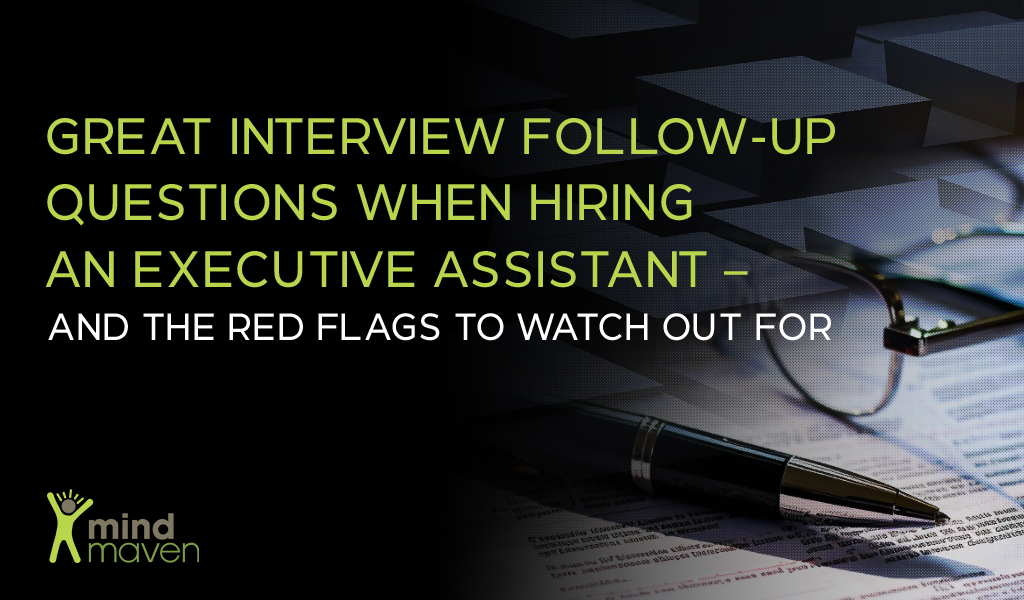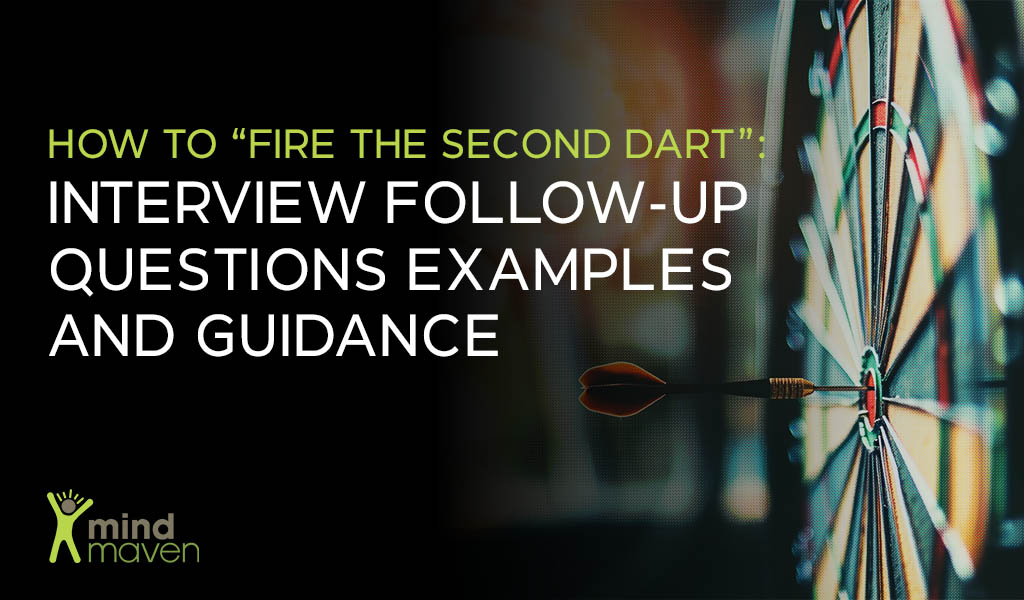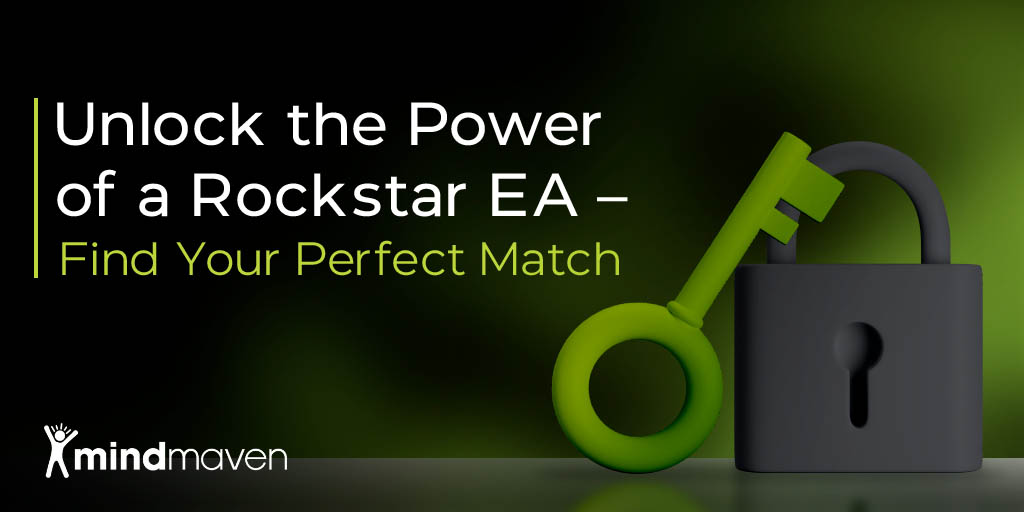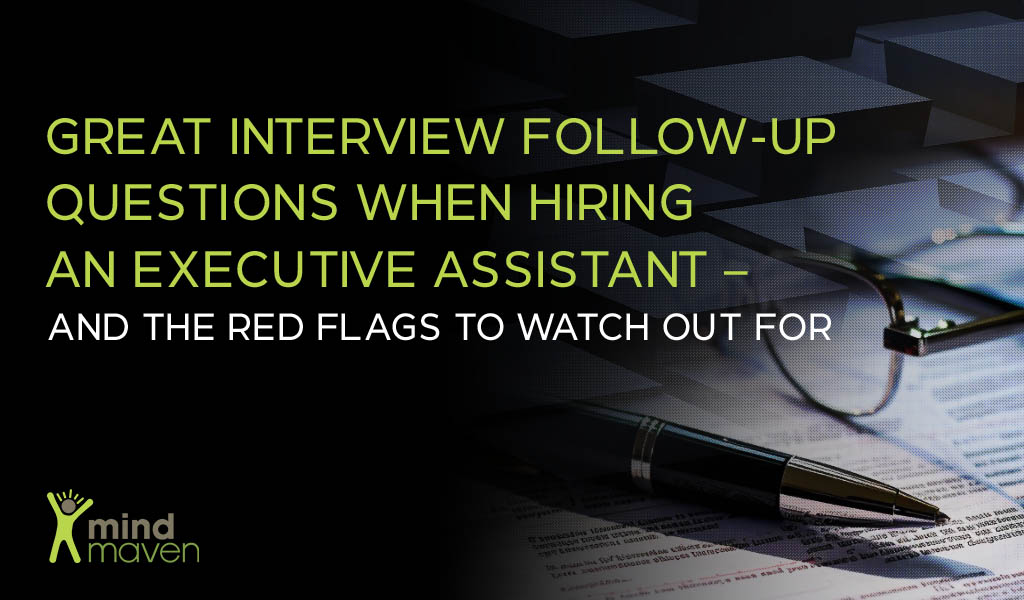
Asking the right interview questions is essential to finding a rockstar Executive Assistant (EA) – but it’s also only the beginning. It’s your interview follow-up questions that reveal a candidate’s true potential and fit.
In our last article, we shared the top 5 Executive Assistant interview questions we use in every search to reveal the qualities that distinguish rockstar EAs from the rest.
(Not caught up? Click here to read Part 1 of this article now.)
And in this article, we’ll be taking things a step further. These next steps are about creating a more meaningful interview experience that will help you identify a candidate who will empower you to operate at your fullest potential.
Keep reading to discover essential interview follow-up questions and red flags to watch for during the interview – ensuring you find a lasting, productive match for you and your team.
Table of Contents
ToggleInterview Follow-Up Questions: How To Find The Right Candidate
Knowing what interview follow-up questions will bring the most insight can make all the difference in identifying the right candidate for your business.
Asking follow-up questions – what we call “firing the second dart” – allows you to move beyond surface-level answers and have a truly meaningful conversation.
Think of your primary interview questions as a warm-up, inviting Executive Assistant candidates to share their thoughts on key topics.
Then, “second dart” interview follow-up questions allow you to uncover the candidate’s core thought patterns, priorities, and how they approach challenges.
How to “Fire the Second Dart”: Interview Follow-Up Questions Examples and Guidance

Effective interview follow-up questions allow you to distinguish rockstar EAs who align with your team’s values. Here’s how to approach it:
1. Move from “What” to “How It Made Them Feel”
- Primary Question: “Can you tell me about a time you felt you were able to make a meaningful difference in someone’s life?”
- Second Dart: “How did it make you feel, doing that for someone else?”
Interview follow-up questions like this help reveal the candidate’s empathy and motivation.
When they reflect on how making a difference felt to them, you gain insight into whether they find fulfillment in supporting others – a key quality in roles centered around helping and uplifting those around them.
Sign of a strong candidate: Listen for genuine expressions of satisfaction and connection, which signal that they’ll likely bring a sense of purpose and commitment to their work.
2. From Receiving Feedback to Reflecting on Personal Growth
- Primary Question: “Can you share a time you received challenging feedback, and how you reacted?”
- Second Dart: “How do you feel that feedback has shaped who you are today?”
By asking this follow-up, you move beyond understanding their initial reaction to the feedback and instead uncover how they internalized and learned from it.
This question reveals their growth mindset and shows whether they embrace feedback as an opportunity for development.
Sign of a strong candidate: Look for candidates who can connect the feedback to tangible changes in their behavior or mindset, indicating they’re committed to self-improvement.
3. Seek Personal Insight from Adversity
- Primary Question: “What’s the adversity you’re most proud to have overcome?”
- Second Dart: “What did that challenge teach you about yourself?”
This question shifts the focus from simply what happened to what they discovered about themselves through the experience.
By exploring how adversity shaped their self-perception, you gain insight into their resilience, self-awareness, and adaptability.
Sign of a strong candidate: Strong candidates will reflect on personal growth, lessons learned, and an ability to turn challenges into learning opportunities.
4. Turn Learning into Insightful Reflections
- Primary Question: “What’s one thing you’ve done in the past 12 months to learn or grow?”
- Second Dart: “Did you have any ‘ah-hah!’ moments? How did they make you feel?”
This follow-up question brings out the candidate’s emotional connection to their learning journey.
When candidates light up about their “ah-hah!” moments, you know they’re driven by curiosity and are likely to bring that energy to their role.
Sign of a strong candidate: Look for candidates who show enthusiasm and a sense of curiosity, which indicates a proactive attitude toward learning.
5. From Dislikes in Culture to Building Positivity
- Primary Question: “What’s an element of company culture from a previous role you want to avoid in future positions?”
- Second Dart: “How do you personally contribute to creating a positive work environment?”
The last of our interview follow-up questions turn a reflection on past challenges into an opportunity to create positive change.
Candidates who thoughtfully answer this are not only aware of the types of environments that support them best but are also committed to contributing to a supportive and collaborative company culture.
Sign of a strong candidate: Look for candidates who describe specific actions or positive attitudes, which show they’re invested in building and maintaining a healthy work environment.
Why Firing the Second Dart Matters: Turning Interviews Into Meaningful Interactions
Firing the second dart isn’t just about gathering additional information; they transform the interview into a memorable and meaningful experience.
Interview follow-up questions encourage candidates to go beyond their rehearsed responses, helping you determine if they truly align with your needs and team culture.
They also give candidates the chance to feel heard, valued, and connected. This approach is a simple but profound shift from asking to understand to asking to connect.
A more meaningful interview experience often results in candidates forming a positive impression of your company. When they feel genuinely connected, they’re more likely to bring their best selves to the interview and, ultimately, to the role.
Practical Tips for Effectively Implementing the Second Dart
- Listen Intently: Don’t rush to the next question. Allow pauses, let the candidate fully express themselves, and make them feel comfortable sharing deeper thoughts.
- Be Open to the Unexpected: Interview follow-up questions can lead to insights that might surprise you. Let the conversation flow naturally instead of strictly sticking to your pre-planned questions.
- Encourage Self-Reflection: Frame questions that prompt candidates to explore how they view themselves and their growth journey. This can often reveal their true character and fit for the role.
By mastering interview follow-up questions, you ensure that your interviews are not just conversations but pathways to discovering the candidates who will bring a new dimension to the role and elevate your team.
When learning these additional insights, it’s also the time to be alert about any potential red flags that might arise, ensuring they truly align with your company’s values and long-term vision.
4 Red Flags to Watch Out for In Executive Assistant Interviews
While interview follow-up questions are designed to reveal positive indicators of compatibility, it’s equally important to stay alert to signs that a candidate might not be the right fit.
Keep in mind: red flags aren’t always immediate deal-breakers; rather, they signal areas worth examining more closely during the evaluation process.
Below are four red flags to be mindful of when asking your interview follow-up questions:
1. Misunderstanding the Mission
An evident lack of understanding of your company and its mission can indicate inadequate preparation.
By the time candidates reach the interview stage, it’s reasonable to expect they’ve done some research into your organization.
What to do: During the interview, ask candidates to describe what they understand about your company and the role in their own words.
This provides a view into their research skills, comprehension, and genuine interest in joining your team.
2. Excessive Negativity
How a candidate speaks about past roles can reveal much about their professionalism and ability to manage relationships.
It’s natural to discuss reasons for leaving prior positions, but excessive negativity can indicate difficulty with teamwork or an unwillingness to take personal responsibility.
Here are a few examples to watch out for:
- Constant complaining about previous employers
- Blaming others for career stagnation
- Lack of personal accountability
- Unwillingness to acknowledge personal learning or growth
- Portraying themselves as the sole victim
- Harboring resentment toward past employers
A strong candidate will provide a balanced, thoughtful perspective, even when recounting challenges. However, if negativity dominates their responses, consider how this outlook could impact your team’s morale and culture.
3. Absence of Curiosity
A lack of questions from a candidate during an interview can imply disinterest or a superficial understanding of the role.
A two-way dialogue with quality questions not only reflects the candidate’s engagement and curiosity but also indicates a proactive mindset essential for growth.
What to watch for: Look for questions that go beyond the basics and reflect genuine curiosity about your company’s culture, values, and vision.
In contrast, if a candidate has no questions or only generic ones, it may signal a lack of strategic thinking.
4. When Confidence Becomes Arrogance
To determine the distinction between a confident candidate and an arrogant one, listen to how they speak about themselves.
Confident candidates present their achievements while acknowledging the contributions of others. They openly discuss their failures and value the lessons they have taught them.
Arrogance, however, can manifest as monopolizing the conversation, a reluctance to admit mistakes, or disregarding teamwork’s importance. They may struggle in a collaborative environment and even disrupt team dynamics.
What to look for: Seek humility and a service-oriented attitude, as these qualities support the cooperative nature of the Executive Assistant role.
Remember, a candidate who believes they have nothing left to learn is unlikely to contribute positively to an environment that values continuous improvement and collective success.
Unlock the Power of a Rockstar EA – Find Your Perfect Match

The difference between a good hire and a great hire often comes down to the right questions.
With strategic interview follow-up questions and an awareness of red flags to watch out for, you’ll ensure your EA candidate is not just capable but truly aligned with your vision and needs.
But we get it – finding that perfect fit is no small task.
If you’d rather focus on your mission and let us take care of the search, we’re here to help.
With over 15 years of experience and a 94% placement success rate, we’ve built a science around pairing leaders with rockstar Executive Assistants.
Schedule a discovery call with Senior Executive Coach Chalyse Elsasser at a time that suits you and get matched with a rockstar EA in as little as 10 days.
In your call, we’ll discuss your needs and preferences and ensure you’re a good fit for our approach.
You’ll learn more about our process and how we’ve revolutionized the role of an Executive Assistant to become the most strategic hire you can make.


